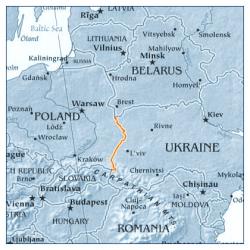
|







|

|


General information
The Polish-Ukrainian border region consists of four administrative provinces. There are Lubelskie and Podkarpackie voivodship on the Polish side of the border (area 43,000 sq km, population 4,36 mln) and Lvivska and Volynska oblast on the Ukrainian side (42,000 sq km, population 3,86 mln) The main capital cities are: Lublin (356,000), Rzeszów (162,000) in Poland and Lviv (810,000), Luck (218,000) in Ukraine. The region can be divided into four main strips of natural landscape. Beginning from the north: accumulation plains with lakes; uplands; intermountain plains and Carpathian Mountains with foothills. The main river is Bug, which constitutes the state borderline in the northern part of the region. Other important rivers are San and Wieprz with tributaries on the Polish side and Dniestr with tributaries on the Ukrainian side. The length of the borderline is 526 km and there are 7 main complexes of crossing-points (road, rail or foot) along this line. The border traffic increased rapidly in the 1990's and reached 10 million people in 1996, and since this time this figure has been quite stable (approximately 11 million people crossed the border in 2000).
 - Regional Coordinator: Dr. Grzegorz Gorzelak
Socio-economic condition and political situation
The structural transformation process that took place in Central and Eastern Europe affected Polish-Ukrainian border regions in quite similar way. Polish Eastern regions, characterised by a large share of agriculture in GDP and employment (i.e. share of agriculture in employment exceed 50% in Lubelskie voivodship), are the "losers" of Polish transformation. The rate of GDP growth is lower than in the rest of the country - especially of the regions with more favourable conditions like large agglomerations and Western regions. Also the inflow of foreign direct investment to Eastern Poland has been very small. The situation is more or less the same on the Ukrainian side. Ukrainian Western regions are traditionally agricultural with low share of industrial output and have insignificant amount of capital investments, both national and foreign with Lviv city exception. The disparities in the level of development (GDP per inhabitant) between Polish and Ukrainian regions are similar to the difference between the border regions of Poland and Germany. The political co-operation seems to be good on the national level, but on regional and local levels some problems have occurred, like reconstructed Polish soldiers' cemetery in Lviv, and conversion of former orthodox church in Przemysl to catholic denomination. However, the two Euroregions were established on Polish-Ukrainian border: Bug and Karpaty to promote cultural and socio-economic trans-border linkages. The characteristic feature of this Euroregions is "upper" level of co-operation (provinces). On the contrary, in the Polish-German Euroregions the main actors are the municipalities.
Challenges for the case study
The main challenges for the case study of the Polish-Ukrainian cross-border co-operation could be the following: - the role of the trans-border co-operation for regional and local development on the two sides of the border;
- the evaluation of the potential for cross-border co-operation on the two sides of the border, especially in the light of the prospected accession of Poland to the European Union;
- the potential for establishing EU-financed programmes on the two sides of the border (Interreg on the Polish side, Cross-border Co-operation on the Ukrainian side);
- the role of the Euroregions in promoting Polish-Ukrainian co-operation;
- the applicability of the Polish-German co-operation for the Polish-Ukrainian case
Studies on Polish Ukrainian crossborder cooperation conducted before
The cross-border co-operation on the whole of the Polish-Ukrainian border region has not been yet a subject of systematic, comprehensive field studies. Nevertheless, the northern part of the region has been studied within a large scientific project led by Lubelska Polytechnic, which aimed at elaboration of economic and spatial development strategy. Also EUROREG carried out a research on a case-study in Eastern Poland on cross-border co-operation. Furthermore, one of three selected case cities was Przemysl, situated on Polish-Ukrainian border. The result of studies quite unambiguously indicated that, on the one hand, the cross-border economic co-operation is still based on trade contacts, with strictly limited supply linkages across the border, and on the other hand, the border traffic is dominated by so called "ants" - people who carry small amounts of commodities across the border, to be traded on the marketplaces, mostly at the Polish side. This shows that the cross-border contacts have not become developed yet and that there is a large potential of establishing dense and broad business, institutional, cultural and social contacts, which would be beneficial for the two sides.
|

|